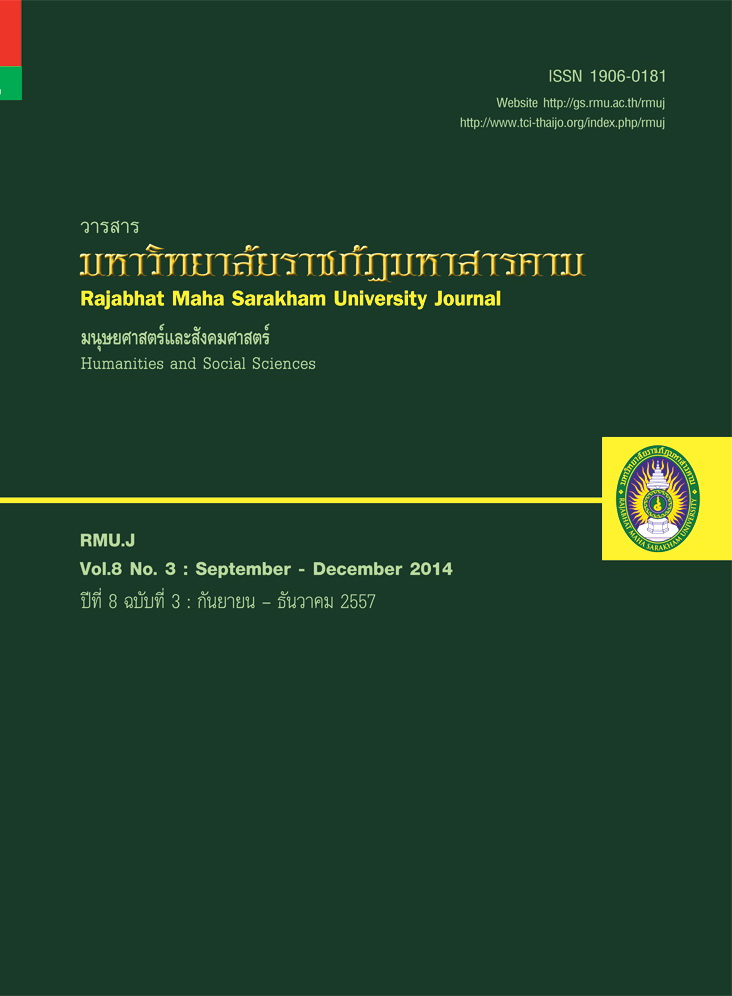การสร้างแบบทดสอบวัดความสามารถในการคิดวิเคราะห์ วิชาวิทยาศาสตร์ สำหรับนักเรียนชั้นประถมศึกษาปีที่ 6 Constructing a Test for Assessing Analytical Thinking Ability in Science of Grade 6th Students
Main Article Content
บทคัดย่อ
การวิจัยครั้งนี้มีวัตถุประสงค์เพื่อ ประการแรก เพื่อสร้างแบบทดสอบวัดความสามารถในการคิดวิเคราะห์ ประการสอง
เพื่อหาคุณภาพของแบบทดสอบวัดความสามารถในการคิดวิเคราะห์ และประการที่สาม สร้างเกณฑ์ปกติระดับท้องถิ่น (Local norms)
ของคะแนนสอบวัดความสามารถในการคิดวิเคราะห์ วิชาวิทยาศาสตร์ สำหรับนักเรียนชั้นประถมศึกษาปีที่ 6 กลุ่มตัวอย่างที่ใช้ในการ
วิจัยเป็นนักเรียนชั้นประถมศึกษาปีที่ 6 ภาคเรียนที่ 1 ปีการศึกษา 2553 สังกัดสำนักงานเขตพื้นที่การศึกษากาฬสินธุ์ เขต 2 จำนวน
400 คน กำหนดขนาดกลุ่มตัวอย่างโดยใช้ตาราง Krejcie Morgan ได้มาด้วยวิธีการสุ่มแบบหลายขั้นตอน (Multi-stage random
sampling) เครื่องมือที่ใช้ในการวิจัย ได้แก่ แบบทดสอบวัดความสามารถในการคิดวิเคราะห์ วิชาวิทยาศาสตร์ สำหรับนักเรียน ชั้น
ประถมศึกษาปีที่ 6 มีลักษณะเป็นแบบปรนัยชนิดเลือกตอบ 4 ตัวเลือก ที่มีองค์ประกอบ 3 ด้าน ได้แก่ ด้านหลักการ ด้านความสำคัญ
และด้านความสัมพันธ์ สถิติที่ใช้ในการวิเคราะห์ข้อมูล ได้แก่ ค่าเฉลี่ย ส่วนเบี่ยงเบนมาตรฐาน ค่าความยากง่าย ค่าอำนาจจำแนก ค่า
ความเชื่อมั่นของแบบวัดทั้งฉบับแบบ KR - 20 การวิเคราะห์ความเที่ยงตรงเชิงโครงสร้างด้วยวิธีวิเคราะห์องค์ประกอบเชิงยืนยัน
(Confirmatory factor analysis : CFA) และการสร้างเกณฑ์ปกติระดับท้องถิ่น (Local norms) ในรูปของคะแนน ที ปกติ (Normalized
t - score) โดยสมการพยากรณ์ ผลการวิจัยพบว่า
1. แบบวัดความสามารถในการคิดวิเคราะห์ วิชาวิทยาศาสตร์ สำหรับนักเรียนชั้นประถมศึกษาปีที่ 6 มีลักษณะเป็นปรนัยชนิด
เลือกตอบ 4 ตัวเลือก จำนวน 1 ฉบับ 45 ข้อ มีองค์ประกอบ 3 ด้าน ได้แก่ ด้านหลักการ 15 ข้อ ด้านความสำคัญ 15 ข้อ ด้านความ
สัมพันธ์ 15 ข้อ
2. คุณภาพของแบบทดสอบวัดความสามารถในการคิดคิดวิเคราะห์ วิชาวิทยาศาสตร์ สำหรับนักเรียนชั้นประถมศึกษาปีที่ 6 มี
ความเที่ยงตรงเชิงเนื้อหาโดยแบบวัดมีค่าดัชนีความสอดคล้องตั้งแต่ 0.80 - 1.00 ความยากง่ายมีค่าตั้งแต่ 0.36 - 0.78 อำนาจจำแนก
มีค่าตั้งแต่ 0.21 - 0.80 ความเชื่อมั่นของแบบวัดทั้งฉบับมีค่าเท่ากับ 0.88 และการวิเคราะห์ความเที่ยงตรงเชิงโครงสร้างด้วยวิธีวิเคราะห์
องค์ประกอบเชิงยืนยัน แบบวัดมีค่านํ้าหนักองค์ประกอบแตกต่างจาก 0 อย่างมีนัยสำคัญทางสถิติที่ระดับ .05 โมเดลมีค่าดัชนีวัดระดับ
ความสอดคล้องกลมกลืนกับข้อมูลเชิงประจักษ์ที่ยอมรับได้นั่นคือ มีค่าไค - สแควร์ ( 2) เท่ากับ 930.39 ค่าไค-สแควร์สัมพัทธ์ ( 2/ df)
เท่ากับ 1.03 ค่า RMSEA เท่ากับ 0.00 ค่าดัชนีวัดระดับความกลมกลืน (GFI) เท่ากับ 0.89 และค่าดัชนีวัดระดับความกลมกลืนที่ปรับ
แก้แล้ว AGFI เท่ากับ 0.88 3. สร้างเกณฑ์ปกติระดับท้องถิ่น (Local norms) ในรูปของคะแนน T ปกติ (Normalized t - score) โดยสมการพยากรณ์
มีค่าคะแนนดิบอยู่ระหว่าง 9 - 41 คะแนน มีค่าคะแนนทีปกติอยู่ระหว่าง T18-T72. และมีการขยายคะแนนเกณฑ์ปกติโดยสมการ
พยากรณ์อยู่ในช่วง Tc18 - Tc 79
The objectives of this research were to 1) construct a test for assessing analytical thinking ability,
2) determine qualities of the test, and 3) establish the local norms of the test scores in analytical thinking
ability. The sample group, the size of which was determined by using the Krejcie& Morgan Table, consisted
of 400
grade 6 students, studying in the first semester of the academic year 2010 in schools under the office of
KalasinPrimary Education Service Area 2 and obtained through multi-stage random sampling to participate
in the study. The instrument used in this study was a four-multiple-choiced test, designed to measure 3 aspects
of analytical thinking ability: principle, importance, and relation. The statistics used in analyzing data of this
study were mean, standard deviation, difficulty index, discrimination power index, KR20 test reliability,
Confirmatory FactorAnalysis:CFA for analyzing content validity, Normalized T- scores for determining local
norms using predicting equation.
Results of the study are as follows:
1. The four-multiple-choiced test for assessing analytical thinking ability of grade6students
consistedof 45 items designed for testing 3 aspects of analytical thinking ability: 15 items on principles, 15
on importance, and the other 15 items on relations.
2. Regarding qualities, the content validity of the test was0.80 - 1.00, with difficulty ranging from
0.36 to0.78, discrimination power from0.21 to0.80. Entire test reliability was0.88. The construct validity of the
test, determined by using confirmatory factor analysis revealedsignificant differences in weights of aspects
at the .05 level. The goodness of fit index (GFI) of the empirical data was acceptable( Chi-square 2 = 930.39,
2/df = 1.03, RMSEA = 0.00), GFI = 0.89, and AGFI = 0.88).
3. The study revealedthat the local norms of the test of grade 6students’ analytical thinking ability
considered from the raw score were in the range of 9 - 41, or within the normalized T-score range of T18- T72
and predicting equation extending were inthe range of T18-T79.
Article Details
1. บทความที่ลงตีพิมพ์ทุกเรื่องได้รับการตรวจทางวิชาการโดยผู้ประเมินอิสระ
2. ข้อคิดเห็นใด ๆ ของบทคามที่ลงตีพิมพ์ในวารสารมหาวิทยาลัยราชภัฏมหาสารคาทม นี้เป็นของผู้เขียน คณะผู้จัดทำวารสารไม่จำเป็นต้องเห็นด้วย
3. กองบรรณาธิการวารสารมหาวิทยาลัยราชภัฏมหาสารคาทม ไม่สงวนสิทธิ์การคัดลอกแต่ให้อ้างอิงแสดงที่มา

